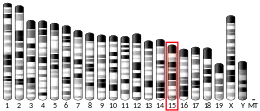DDX17
Probable ATP-dependent RNA helicase DDX17 (p72) is an enzyme that in humans is encoded by the DDX17 gene.[5][6]
Function
DEAD box proteins, characterized by the conserved motif Asp-Glu-Ala-Asp (DEAD), are putative RNA helicases. They are implicated in a number of cellular processes involving alteration of RNA secondary structure such as translation initiation, nuclear and mitochondrial splicing, and ribosome and spliceosome assembly. Based on their distribution patterns, some members of this family are believed to be involved in embryogenesis, spermatogenesis, and cellular growth and division. This gene encodes a DEAD box protein, which is an ATPase activated by a variety of RNA species but not by dsDNA. This protein and that encoded by DDX5 gene are more closely related to each other than to any other member of the DEAD box family. Alternative splicing of this gene generates 2 transcript variants encoding different isoforms with the longer transcript reported to also initiate translation at a non-AUG (CUG) start site.[6]
Interactions
DDX17 has been shown to interact with:
References
- GRCh38: Ensembl release 89: ENSG00000100201 - Ensembl, May 2017
- GRCm38: Ensembl release 89: ENSMUSG00000055065 - Ensembl, May 2017
- "Human PubMed Reference:". National Center for Biotechnology Information, U.S. National Library of Medicine.
- "Mouse PubMed Reference:". National Center for Biotechnology Information, U.S. National Library of Medicine.
- Lamm GM, Nicol SM, Fuller-Pace FV, Lamond AI (Dec 1996). "p72: a human nuclear DEAD box protein highly related to p68". Nucleic Acids Res. 24 (19): 3739–47. doi:10.1093/nar/24.19.3739. PMC 146168. PMID 8871553.
- "Entrez Gene: DDX17 DEAD (Asp-Glu-Ala-Asp) box polypeptide 17".
- Ogilvie VC, Wilson BJ, Nicol SM, Morrice NA, Saunders LR, Barber GN, Fuller-Pace FV (2003). "The highly related DEAD box RNA helicases p68 and p72 exist as heterodimers in cells". Nucleic Acids Res. 31 (5): 1470–80. doi:10.1093/nar/gkg236. PMC 149829. PMID 12595555.
- Wilson BJ, Giguère V (Nov 2007). "Identification of novel pathway partners of p68 and p72 RNA helicases through Oncomine meta-analysis". BMC Genomics. 8: 419. doi:10.1186/1471-2164-8-419. PMC 3225811. PMID 18005418.
- Wilson BJ, Bates GJ, Nicol SM, Gregory DJ, Perkins ND, Fuller-Pace FV (Aug 2004). "The p68 and p72 DEAD box RNA helicases interact with HDAC1 and repress transcription in a promoter-specific manner". BMC Mol. Biol. 5: 11. doi:10.1186/1471-2199-5-11. PMC 514542. PMID 15298701.
Further reading
- Lüking A, Stahl U, Schmidt U (1998). "The protein family of RNA helicases". Crit. Rev. Biochem. Mol. Biol. 33 (4): 259–96. doi:10.1080/10409239891204233. PMID 9747670.
- Andersson B, Wentland MA, Ricafrente JY, Liu W, Gibbs RA (1996). "A "double adaptor" method for improved shotgun library construction". Anal. Biochem. 236 (1): 107–13. doi:10.1006/abio.1996.0138. PMID 8619474.
- Yu W, Andersson B, Worley KC, Muzny DM, Ding Y, Liu W, Ricafrente JY, Wentland MA, Lennon G, Gibbs RA (1997). "Large-Scale Concatenation cDNA Sequencing". Genome Res. 7 (4): 353–8. doi:10.1101/gr.7.4.353. PMC 139146. PMID 9110174.
- Dunham I, Shimizu N, Roe BA, Chissoe S, Hunt AR, Collins JE, Bruskiewich R, Beare DM, Clamp M, Smink LJ, Ainscough R, Almeida JP, Babbage A, Bagguley C, Bailey J, Barlow K, Bates KN, Beasley O, Bird CP, Blakey S, Bridgeman AM, Buck D, Burgess J, Burrill WD, O'Brien KP (1999). "The DNA sequence of human chromosome 22". Nature. 402 (6761): 489–95. Bibcode:1999Natur.402..489D. doi:10.1038/990031. PMID 10591208.
- Uhlmann-Schiffler H, Rössler OG, Stahl H (2002). "The mRNA of DEAD box protein p72 is alternatively translated into an 82-kDa RNA helicase". J. Biol. Chem. 277 (2): 1066–75. doi:10.1074/jbc.M107535200. PMID 11675387.
- Hönig A, Auboeuf D, Parker MM, O'Malley BW, Berget SM (2002). "Regulation of Alternative Splicing by the ATP-Dependent DEAD-Box RNA Helicase p72". Mol. Cell. Biol. 22 (16): 5698–707. doi:10.1128/MCB.22.16.5698-5707.2002. PMC 133985. PMID 12138182.
- Ohta S, Shiomi Y, Sugimoto K, Obuse C, Tsurimoto T (2002). "A proteomics approach to identify proliferating cell nuclear antigen (PCNA)-binding proteins in human cell lysates. Identification of the human CHL12/RFCs2-5 complex as a novel PCNA-binding protein". J. Biol. Chem. 277 (43): 40362–7. doi:10.1074/jbc.M206194200. PMID 12171929.
- Lee CG (2002). "RH70, a bidirectional RNA helicase, co-purifies with U1snRNP". J. Biol. Chem. 277 (42): 39679–83. doi:10.1074/jbc.C200337200. PMID 12193588.
- Ogilvie VC, Wilson BJ, Nicol SM, Morrice NA, Saunders LR, Barber GN, Fuller-Pace FV (2003). "The highly related DEAD box RNA helicases p68 and p72 exist as heterodimers in cells". Nucleic Acids Res. 31 (5): 1470–80. doi:10.1093/nar/gkg236. PMC 149829. PMID 12595555.
- Fujita T, Kobayashi Y, Wada O, Tateishi Y, Kitada L, Yamamoto Y, Takashima H, Murayama A, Yano T, Baba T, Kato S, Kawabe Y, Yanagisawa J (2003). "Full activation of estrogen receptor alpha activation function-1 induces proliferation of breast cancer cells". J. Biol. Chem. 278 (29): 26704–14. doi:10.1074/jbc.M301031200. PMID 12738788.
- Li J, Hawkins IC, Harvey CD, Jennings JL, Link AJ, Patton JG (2003). "Regulation of Alternative Splicing by SRrp86 and Its Interacting Proteins". Mol. Cell. Biol. 23 (21): 7437–47. doi:10.1128/MCB.23.21.7437-7447.2003. PMC 207616. PMID 14559993.
- Wilson BJ, Bates GJ, Nicol SM, Gregory DJ, Perkins ND, Fuller-Pace FV (2005). "The p68 and p72 DEAD box RNA helicases interact with HDAC1 and repress transcription in a promoter-specific manner". BMC Mol. Biol. 5: 11. doi:10.1186/1471-2199-5-11. PMC 514542. PMID 15298701.
- Jin J, Smith FD, Stark C, Wells CD, Fawcett JP, Kulkarni S, Metalnikov P, O'Donnell P, Taylor P, Taylor L, Zougman A, Woodgett JR, Langeberg LK, Scott JD, Pawson T (2004). "Proteomic, functional, and domain-based analysis of in vivo 14-3-3 binding proteins involved in cytoskeletal regulation and cellular organization". Curr. Biol. 14 (16): 1436–50. doi:10.1016/j.cub.2004.07.051. PMID 15324660. S2CID 2371325.
- Suzuki Y, Yamashita R, Shirota M, Sakakibara Y, Chiba J, Mizushima-Sugano J, Nakai K, Sugano S (2004). "Sequence Comparison of Human and Mouse Genes Reveals a Homologous Block Structure in the Promoter Regions". Genome Res. 14 (9): 1711–8. doi:10.1101/gr.2435604. PMC 515316. PMID 15342556.
- Collins JE, Wright CL, Edwards CA, Davis MP, Grinham JA, Cole CG, Goward ME, Aguado B, Mallya M, Mokrab Y, Huckle EJ, Beare DM, Dunham I (2005). "A genome annotation-driven approach to cloning the human ORFeome". Genome Biol. 5 (10): R84. doi:10.1186/gb-2004-5-10-r84. PMC 545604. PMID 15461802.






